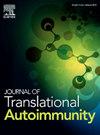Epigenetic regulation of thrombo-inflammation in Behçet and antiphospholipid syndrome
IF 3.6
Q2 IMMUNOLOGY
引用次数: 0
Abstract
Background
An epigenetic regulation of thrombo-inflammation has been reported in Behçet syndrome (BS), likely driven by a unique profile of three plasmatic circulating microRNAs (ci-miRNAs) (miR-206, miR-224-5p, and miR-653-5p). We compared this ci-miRNAs expression in BS and antiphospholipid syndrome (APS), the prototype of acquired pro-thrombotic autoimmune disease. To further corroborate the hypothesis that shared mechanisms drive the thrombotic process in BS and APS, we further assessed their thrombin generation assay (TGA) profile.
Methods
The three ci-miRNA expression was evaluated in 39 patients with BS, 33 with APS and 30 healthy controls (HCs). Single marker and combined ROC curve analyses were performed. TGA was conducted on pre-collected platelet poor plasma samples from 35 patients with BS and 77 with APS.
Results
The three ci-miRNAs, taken individually or combined, lacked acceptable discriminating power between groups [AUC from combiROC 0.64 (95 % CI: 0.51–0.78)]. Conversely, in the subgroups of BS and APS patients with vascular involvement (n = 22 each), the combined signature well discriminated between the two syndromes [AUC 0.83 (0.71–0.96), specificity 0.91, sensitivity 0.77], as well as between thrombotic APS and HCs [AUC 0.79 (0.64–0.91)]. Also, distinct trends in thrombograms emerged between BS and APS, with BS TGA displaying lower tLag and tPeak, higher Peak and similar AUC as compared to APS.
Conclusions
Despite shared elements in the ci-miRNA regulation of their pro-thrombotic tendency, distinct epigenetic factors seem to contribute to the pathogenesis of vascular events in BS and APS, possibly accounting also for the different global clotting assay observed in these diseases.
behet和抗磷脂综合征中血栓炎症的表观遗传调控
behet综合征(BS)的血栓炎症的表观遗传调控已被报道,可能是由三种血浆循环microrna (ci- mirna)的独特谱(miR-206, miR-224-5p和miR-653-5p)驱动的。我们比较了这种ci-miRNAs在BS和抗磷脂综合征(APS)中的表达,APS是获得性促血栓性自身免疫性疾病的原型。为了进一步证实BS和APS的共同机制驱动血栓形成过程的假设,我们进一步评估了它们的凝血酶生成测定(TGA)谱。方法对39例BS患者、33例APS患者和30例健康对照(hc)进行3种ci-miRNA的表达测定。进行单标记和联合ROC曲线分析。对35例BS患者和77例APS患者预采集的血小板不良血浆样本进行TGA分析。结果这3种CI - mirna,单独或联合使用,在组间缺乏可接受的鉴别能力[组合roc的AUC为0.64 (95% CI: 0.51-0.78)]。相反,在血管受损伤的BS和APS患者亚组(n = 22)中,两种综合征(AUC 0.83(0.71-0.96),特异性0.91,敏感性0.77)以及血栓性APS和hcc之间的联合特征(AUC 0.79(0.64-0.91))得到了很好的区分。此外,BS和APS之间的血栓图呈现出明显的趋势,与APS相比,BS TGA显示出较低的flag和tPeak,较高的Peak和相似的AUC。结论:尽管ci-miRNA调控其促血栓倾向的共同因素,但不同的表观遗传因素似乎有助于BS和APS血管事件的发病机制,可能也解释了在这些疾病中观察到的不同的整体凝血测定。
本文章由计算机程序翻译,如有差异,请以英文原文为准。
求助全文
约1分钟内获得全文
求助全文
来源期刊

Journal of Translational Autoimmunity
Medicine-Immunology and Allergy
CiteScore
7.80
自引率
2.60%
发文量
33
审稿时长
55 days
 求助内容:
求助内容: 应助结果提醒方式:
应助结果提醒方式:


